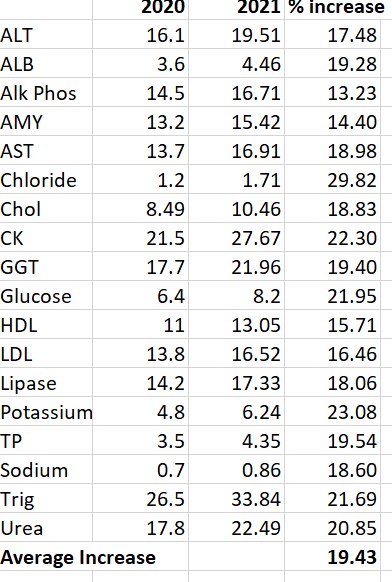Quality Requirements and Standards
2021 Analytical Performance Specification Update, Chemistry
Every year we like to update and review analytical performance standards. Some years are harder than others. Looking at the latest update of EuBIVAS is some interesting good news - bad news.
2021 analytical performance specifications update
February 2021
Sten Westgard, MS
With Special Thanks to Yeffrid Yalta, SIMED
Every year we like to update and review the consolidated chemistry analytical performance specifications that are out in the world. Usually there is not much to report on - CLIA remains rooted in the 1990s, despite their 2019 proposal to update specifications.
The most dynamic goals are those being generated by the EuBIVAS database, the EFLM project to collect new and better biological variation data.
But the latest update, for chemistry analytes, is quite significant.

For the "bread and butter" assays of biochemistry, the adjustments of the goals was almost 20% larger.
The good news: many of the previous year goals were considered so small as to be impossible to achieve. Increases in the size of the goal may bring some of these targets within reach of today's technology.
The bad news: if the goals are going to fluctuate this much from year to year, that may mean they will be unreliable for a few more years, until a critical mass of data starts to stabilize these estimates.
Another interesting feature, pointed out to me by Yeffrid Yalta at SIMED:
- In November 2019, there were 96 updated tests
- In December 2020, there were 112 updated tests
So if from 2019 to 2020, the database increased by 16 additional tests, and it currently stands at 112 tests, and the Ricos database currently has more than 350 tests...
It's going to take about 15 more years before the EuBIVAS will catch up to the Ricos database. Given that the Ricos database itself was considered "out of date" after it had been going for 15 years, that's a significant time lapse.
In 15 years, many of the EuBIVAS database papers themselves will be considered out of date, and the process will start over again.
My point here - the Ricos database still has a very important role to play while the EuBIVAS database builds itself to completion. And ultimately, there is no final set of goals. There are always new tests being added, new methods being improved, new clinical uses being created. The goals will always change. Hopefully, though, not by 20% a year.
